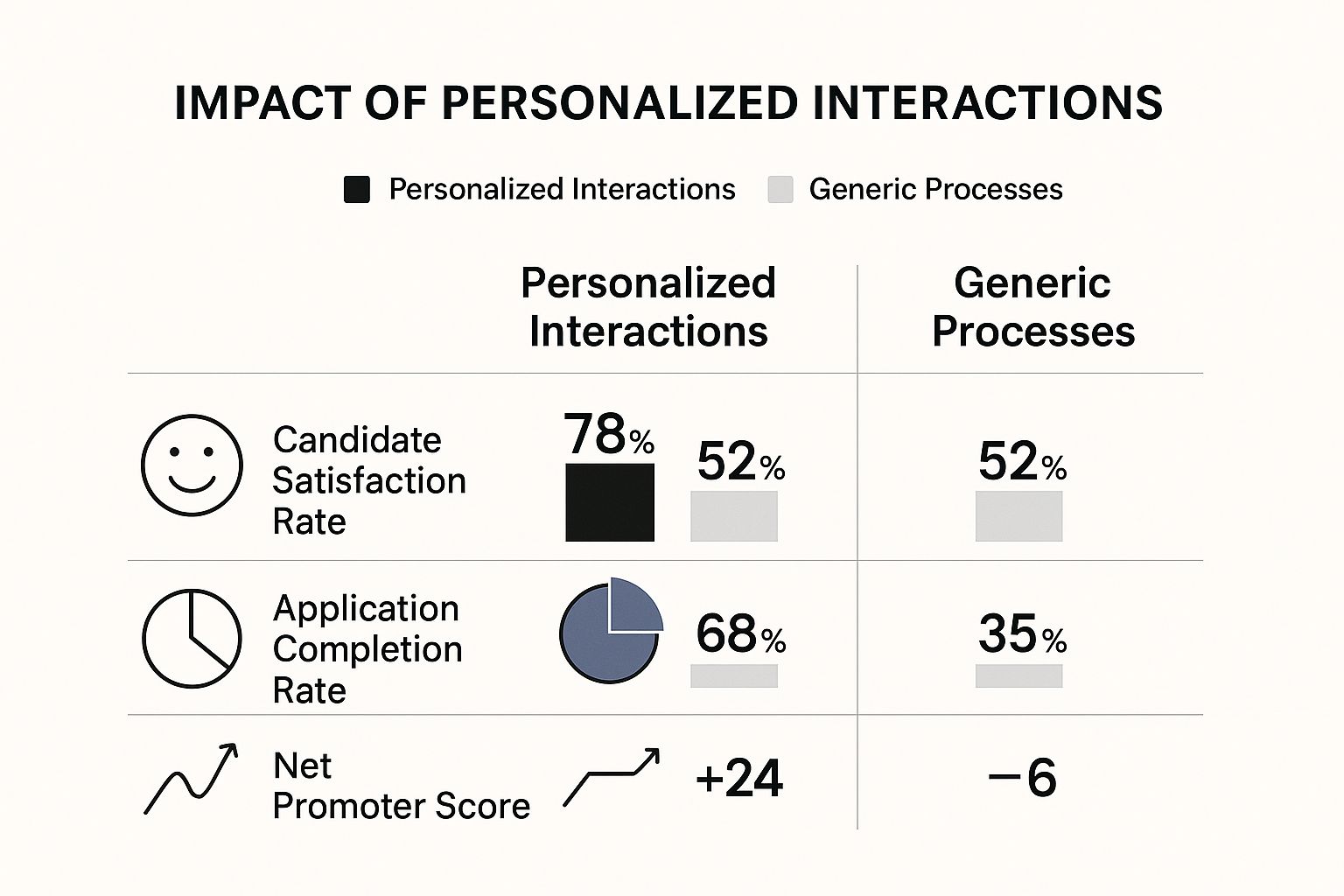August 2, 2025
How to Improve Candidate Experience: A Recruiter's Essential Guide

Creating a standout candidate experience isn't just about bells and whistles; it's a careful blend of smart technology and genuine human connection at every single touchpoint. It boils down to respectful communication, a frictionless application process, and transparent interactions. The goal is simple: make sure every applicant, whether they get the job or not, walks away with a positive impression of your brand.
Why Candidate Experience Defines Your Hiring Success

Let's be blunt: a poor candidate experience isn't a minor hiccup. It's a direct threat to your brand and your bottom line. In a market where top talent has plenty of options, the way you treat applicants is a public reflection of your company's real values and culture. Their perception of your hiring process can easily become the deciding factor.
A bad experience doesn't just mean a withdrawn application. The fallout can ripple through your business for years. Unhappy candidates talk. They share their stories with friends, post reviews on Glassdoor and LinkedIn, and might even stop buying your products. That kind of damage to your employer brand makes attracting great people in the future much harder and more expensive.
The Real Cost of a Poor Process
This isn't just about feelings; the numbers tell a stark story. Take the strange situation in the United States, where recruiting teams are hiring quickly but can't get people to say yes. They're making an average of 54 hires monthly—a whopping 85% higher than the global average—but their offer acceptance rates are stuck at just 79%.
Think about that. Nearly one in five candidates who make it all the way to an offer turns it down. More often than not, it’s because they had a frustrating or disrespectful experience along the way. The 2025 Global Recruitment Report from StaffingHub sheds more light on just how much the talent acquisition landscape is changing.
Your hiring process is one of your most visible marketing tools. Every interaction is a chance to build your reputation, even with the candidates you don't end up hiring.
To build a truly effective hiring process, it helps to understand the foundational elements that shape a candidate's perception. The table below breaks down the core pillars of an exceptional candidate journey.
Core Pillars of an Enhanced Candidate Experience
By focusing on these four pillars, you create a system that not only attracts talent but also actively builds your brand with every single interaction.
Shifting From Transaction to Relationship
Ultimately, improving the candidate experience requires a fundamental mindset shift. You have to move away from seeing hiring as a simple transaction and start treating it as an opportunity to build relationships. You're not just processing paperwork; you're engaging with potential future employees, brand evangelists, and even customers.
When you get this right, the payoff is huge:
- Higher Offer Acceptance Rates: Candidates who feel genuinely valued are far more likely to say "yes."
- A Stronger Talent Pipeline: Applicants you couldn't hire today become a warm pool of talent for tomorrow's openings.
- An Enhanced Employer Brand: Positive word-of-mouth brings better candidates to you, cutting down on what you spend on job ads.
A superior candidate experience isn't a "nice-to-have"—it's a critical component of any modern talent acquisition strategy. For a deeper look at overhauling your entire hiring function, check out our complete guide on how to improve your recruitment process.
Making a Memorable First Impression
Let's be honest, the candidate journey doesn't start when someone hits the "apply" button. It begins way before that—with the very first impression you make. This early stage is your golden opportunity to grab a great candidate's attention and show them why your company is different from all the rest. If you get it right, you'll turn passive scrollers into genuinely interested applicants.
It all boils down to creating a positive experience built on clarity, a personal touch, and simplicity.
Your job descriptions are the first place to start. It’s time to move past the stale, laundry list of duties and qualifications. Instead, think of it as telling a story. Weave a narrative about the role, the team they’d be joining, and what your company culture actually feels like. Use straightforward language and ditch the internal jargon that only confuses people. Frame the position around the impact they can make and the growth they can expect. You want them to start picturing themselves succeeding with you.
Turn Your Career Site Into a Talent Magnet
Think of your career site as more than just a job board. It's the digital front door for anyone considering working with you. It has to be intuitive, work flawlessly on a phone, and give a real sense of your employer brand. This is your chance to show off what makes your workplace special. Use real employee stories, behind-the-scenes videos, and be upfront about your company’s mission and values.
Here's where many companies, even the big players, drop the ball. A deep dive into Fortune 500 companies found some surprising gaps. A whopping 88% failed to suggest other relevant jobs based on a candidate’s skills. On top of that, 87% got low marks for using AI to personalize the experience on their career sites, and 83% didn't have chatbots that could offer smart job recommendations. Many have nailed the mobile application part, but they’re failing to guide talent effectively once they land on the site. You can explore the full analysis of Fortune 500 candidate experiences to see just how big these gaps are.
The goal is to make every candidate feel seen and understood from their very first click. A personalized career site shows you're invested in finding the right person, not just filling an empty chair.
Streamline the Application Process
So you've captured their interest—fantastic. Now, the application itself can either make or break the entire experience. Today’s candidates have zero patience for clunky, repetitive forms that feel like a chore. If the process isn't smooth, they'll just move on.
Here are a few practical ways to fix this crucial step:
- Think Mobile-First, Always: A huge number of top candidates are looking for jobs on their phones. Your application must be easy to complete on any device.
- Keep it Under Five Minutes: The longer the application, the more people you'll lose. Show you respect their time by asking only for what's absolutely necessary at this stage.
- Offer One-Click Apply: Let people apply using their LinkedIn or other professional profiles. It dramatically cuts down on the tedious manual data entry they hate.
- Use Smart Screening on Your End: Instead of a long, drawn-out form, you can use tools like Klearskill to instantly analyze a resume for the key skills you need. This gives you rich data without making the applicant jump through hoops.
Taking this approach doesn't just make candidates happier; it’s a huge win for your recruiting team, too. By capturing the essential info in a quick, painless way, you build a much stronger pipeline. You can spot the best contenders faster, all while making sure every single person who applies walks away with a great impression of your company.
It's Time to Close the Application Black Hole for Good

Here we are. The moment of truth. A talented candidate has just spent their valuable time and energy applying for your open role. What you do next—or, more often, what you don't do—will completely define their opinion of your company.
The most common mistake in hiring is also the most damaging: radio silence. This is the dreaded "application black hole," where great first impressions go to die and top candidates are left feeling ignored and disrespected. It's a reputation killer.
If you're serious about improving your candidate experience, ending this cycle isn't optional. It’s about more than just being polite; it's a strategic move. The fix is simple in concept: proactive and transparent communication. Every single applicant deserves to know where they stand.
This doesn't mean your team has to be buried in manual emails. In fact, this is exactly where thoughtful automation can become your secret weapon.
Designing a Communication Flow That Shows Respect
Your first move should be setting up an automated confirmation email that’s triggered the second an application hits your system. It’s a small touch, but it instantly tells the candidate, "We got it. You're not shouting into the void."
But don't just stop at a simple confirmation. A truly effective communication workflow keeps promising candidates warm and engaged. Here's a blueprint I've seen work time and time again:
- Acknowledge Immediately: Your first email should thank them, confirm you received their application, and—most importantly—set a realistic timeline. Something as simple as, “Our team is reviewing applications over the next two weeks, and we’ll be in touch if your profile aligns with the role,” works wonders.
- Provide Status Updates: Is your review process taking longer than you thought? Don't leave them hanging. A quick, automated follow-up saying, “We’re still carefully reviewing applications and appreciate your continued patience,” shows you respect their time.
- Close the Loop with Everyone: Every candidate who applied deserves a final answer. For those who aren't moving forward, a polite, well-worded rejection email is infinitely better than silence. This simple act of courtesy protects your employer brand and leaves the door open for future roles.
A consistent communication plan proves you value every person who took the time to apply. It turns the anxious waiting game into a professional, transparent process—a true cornerstone of an exceptional candidate experience.
How to Add Value, Even in Rejection
The way you say "no" speaks volumes about your company's culture. While you can't write a personalized feedback essay for every applicant, you can still offer something valuable. This is where modern screening tools can really change the game.
Klearskill, for example, uses AI to provide objective, skills-based insights into every candidate. Imagine being able to share a small piece of that data with someone who was a strong contender but not the final choice. Instead of a generic template, you could offer a genuine takeaway, like pointing out the specific strengths the assessment identified.
This turns a moment of rejection into a constructive interaction. You leave the candidate with a positive feeling and useful information for their ongoing job search. By showing genuine respect for their effort, you're not just improving one person's experience—you're building a network of brand advocates. This approach not only helps with immediate hiring goals but also strengthens your talent pipeline for the future, which is a key part of any good set of candidate sourcing strategies.
Designing a Respectful and Insightful Interview
The interview is the make-or-break moment in your candidate journey. All the goodwill you've built up can evaporate with a single, poorly handled interview. This isn't the time for a one-sided interrogation; it's a chance to have a genuine, two-way conversation that effectively assesses skills while leaving the candidate with a positive impression.
Your main goal is to create an experience that feels both respectful and insightful. A huge part of this falls on your hiring managers. They need to be well-versed in structured interviewing techniques that are designed to evaluate job-relevant skills, not just rely on "gut feelings." This consistency is what leads to fairer, smarter, and less biased hiring decisions.
Don't forget to prepare the candidate, too. A simple email with an agenda, a list of who they'll be meeting, and the main goals of the discussion can make a world of difference. When you empower them to prepare, you get a much more accurate look at what they can really do.
Creating a Consistent Experience Across All Formats
Whether it’s a quick phone screen, a video call, or a final in-person meeting, the core principles of respect and clarity should always shine through. Of course, each format has its own nuances you need to get right.
- Video Interviews: Always test your tech first and send clear instructions to the candidate. Make a conscious effort to look at the camera, not just your screen—it’s the virtual equivalent of making eye contact and helps build a real connection.
- Phone Screens: Without any visual cues to rely on, your tone of voice does all the heavy lifting. Practice active listening and resist the urge to multitask. The candidate can tell when you're not fully present.
- In-Person Meetings: Make them feel welcome from the second they walk in the door. Offer a glass of water, maybe give a quick tour of the office, and make sure the interview room is private and comfortable.
The effort you put into personalizing these interactions pays off massively. Generic, one-size-fits-all processes just can't compete.

The data speaks for itself. Candidates who feel they are part of a thoughtful, personalized process are far more likely to stay engaged and walk away with a positive view of your company, no matter the outcome.
To nail this stage, it's helpful to contrast what a great process looks like with common pitfalls.
Interview Stage Do's and Don'ts
Following these best practices shows respect for the candidate's time and effort, reinforcing a positive employer brand.
Actively Gathering and Using Feedback
How can you be sure your interview process is hitting the mark? You have to ask. Proactively seeking feedback from candidates—yes, even the ones you don’t hire—is one of the most powerful things you can do. It creates a feedback loop that helps you continuously improve.
Your interview process is being evaluated just as much as the candidate is. Treating it as a two-way street—where you're also being interviewed—is the key to making a lasting positive impression.
After an interview, send a short, anonymous survey. Ask about their experience with the scheduling, the interviewers, and the questions they were asked. This feedback is gold. It helps you uncover hidden problems, like an interviewer who’s always running late or a question that consistently confuses people. By showing you value their input, you demonstrate a culture of respect and ensure every person who interviews with you leaves with a positive feeling about your brand.
Mastering the Offer and Rejection Process

The final moments of the hiring process—the offer and rejection—are where your company's reputation is truly made or broken. How you handle these last conversations determines whether a candidate becomes a productive new hire or a vocal critic on Glassdoor. It’s your last, best chance to leave a lasting, positive impression.
When you're ready to make an offer, treat it like a celebration, not a transaction. This is the moment to validate all the candidate's hard work and reinforce why they were right to choose you. A phone call from the hiring manager, buzzing with genuine enthusiasm, is always going to land better than a cold, impersonal email. That personal touch makes a candidate feel wanted and valued, which can dramatically increase your offer acceptance rate.
The Art of the Graceful Rejection
Equally important is knowing how to deliver a graceful rejection. Ghosting candidates or firing off a curt, automated email after they've spent hours in interviews is a fast track to damaging your employer brand. For anyone who made it to the final rounds, a brief, personal phone call is the professional standard.
Thank them for their time, mention a specific strength you noticed, and if you can, offer a small piece of constructive feedback. This simple act of respect can transform a disappointing moment into a positive brand interaction. You might just turn rejected candidates into advocates who reapply or refer others down the line. It’s a core principle you'll find in the best recruitment practices that top-tier companies swear by.
Every "no" you deliver is an opportunity to build goodwill. A respectful rejection preserves the relationship and keeps the door open for future opportunities, strengthening your long-term talent pool.
This level of care is especially critical right now, as more people are looking for stability. A recent survey revealed that while 42% of candidates plan to stay in their next role for three to five years, a combined 47% are aiming for six years or more. These candidates are searching for clues about a supportive company culture from day one, and a thoughtful rejection process speaks volumes.
From Offer Acceptance to Day One Success
Once they've said "yes," your work isn't finished. The time between acceptance and their first day is a fragile period where you have to keep the momentum going. This "pre-boarding" phase is your chance to keep your new hire excited and engaged.
Here are a few high-impact things you can do:
- Handle Logistics Swiftly: Get all the necessary paperwork sent over digitally with clear instructions. Don't make their first official task a bureaucratic nightmare.
- Send a Welcome Packet: It doesn't have to be extravagant. A small box with company swag, a welcome note from the CEO, and a first-week agenda can make a huge difference.
- Introduce the Team: Why not set up a casual virtual coffee with their immediate colleagues before they even start? It's a great way to break the ice and makes their first day far less intimidating.
By creating a smooth transition from candidate to employee, you confirm they made the right choice and set them up for success from the minute they walk in the door. It's the final, crucial step that shows you're a company that genuinely invests in its people.
Frequently Asked Questions
Even with a solid game plan, you're bound to run into some specific questions when you start working to improve your candidate experience. I get asked these all the time by recruiters and hiring managers, so let's tackle a few of the most common ones.
How Can A Small Company With Limited Resources Improve Its Candidate Experience?
You don't need a massive budget to make a real difference. It’s all about focusing your energy on the small things that have a huge impact.
Start with clear and consistent communication. It’s the bedrock of a good experience. Setting up simple email templates to acknowledge every application and keep people in the loop costs you nothing but time, and it stops candidates from feeling like their resume vanished into a black hole.
Next, take a hard look at your job descriptions. Are they clear, compelling, and—most importantly—honest? Finally, just treat every single person you interview with respect. A positive, human-to-human interaction is free, but its value in building your employer brand is priceless.
Is It Ever Okay Not to Provide Feedback to Rejected Candidates?
This is a tricky one, and the honest answer is: it depends on the stage.
For candidates who only submitted an application, sending personalized, detailed feedback just isn't realistic for most companies. A polite, timely, and empathetic rejection notice is perfectly fine.
But for anyone who invested their time to interview with you? That’s a different story. Offering them some brief, constructive feedback is a powerful gesture. It can be a short call or a well-crafted email.
When you offer feedback to an interviewed candidate, you're not just closing a loop; you're investing in a future relationship. That person may reapply, refer someone else, or become a customer one day.
What's The Single Biggest Mistake Companies Make?
Hands down, the most damaging and common mistake is what I call the "application black hole." It’s that complete radio silence after someone applies, and it's the quickest way to make a candidate feel disrespected and frustrated.
We all get swamped with applications, but the feeling of being ignored is what really poisons your reputation.
A simple automated email confirming you got their application and giving a rough timeline is a game-changer. It’s the absolute bare minimum for any company that's serious about improving its candidate experience.
Ready to stop spending hours on manual resume screening and start focusing on the best-fit candidates? Klearskill uses AI to provide instant, unbiased insights, cutting screening time by 92% while ensuring you never miss top talent. Start hiring smarter today.
